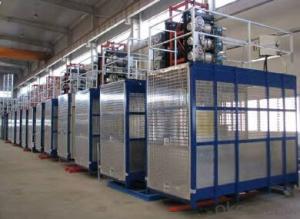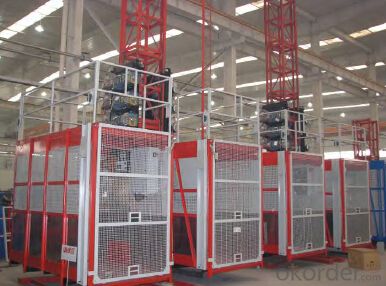High Quality Construction hoist Building Hoist SCD250/250
- Loading Port:
- Tianjin
- Payment Terms:
- TT OR LC
- Min Order Qty:
- 1 unit
- Supply Capability:
- 1000 unit/month
OKorder Service Pledge
OKorder Financial Service
You Might Also Like
Specification
High Quality Construction hoist Building Hoist


Descriptions of our building hoist:
The general building hoist manufactured by our company have the features as good quality, long life, wide application range and convenient for maintenance, the gering adopts imported bearing, enameled cable, and oil seal, the electric parts adopt products from world renowned manufactures such as Schneider, Siemens, and LG, the racks and pinion adopts special material and heat-treatment technique, which prolong the life of these parts. The steel structure uses quality steel from famous domestic manufacturers, the surface of the structure can apply paint-spray, Parkerizing baking finish or hot galvanizing processing according to users requirements, the cage can be produced and decorated by aluminum molded board, punched-plate or figured aluminum board.
Main Features of Building Material Hoist
1. the recommended cage dimension(LXWXH):2.0X1.0X2.5, 2.5X1.0X2.5, 2.5X1.3X2.5, 3.0X1.5X2.5, 3.2X1.5X2.5, 3.8X1.5X2.5, 4.0X1.5X2.5, 4.2X1.5X2.5 etc, we can also manufacture cages of other size according to the user.
2. The cage and the door material can be aluminum molded board, punched-plate, figured aluminum board or other type according to your requirements.
3. The mast and the tie-in surface can adopt paint-spray, or hot galvanizeing processing.
Advantage of our building hoist:
1. Our own systems of production engineering.
2. Production design from the concept to the engineering details.
3. Technical experts with great experience in the sector.
4. Continuous development of new solutions and products adapted to the requirements of our clients.
5. Methodology and project procedure administration in compliance with current guidelines.
6. Extensive worldwide commercial network
Specification of our building hoist:

1. why chose us?
China National Building Materials (Group) Corporation (CNBM), established in 1984,now is one of the largest state-owned group corporation in China, dealing with building materials & industrial equipment. Up to year 2010, CNBM Group's total asset is 20 billion USD and total staff is more than 100,000.CNBM International Corporation, specializes in designing & manufacturing of various
kinds of construction machinery, including tower crane, building hoist, etc. All the equipment produced by CNBM are compliant with the National level quality standard, and wins great reputation for their endurable performance in worldwide markets.
2.How about the shipment?
You can put 2 sets of of wheel loaders in one 40HQ container. The spare parts are packed with boxes.
The delivery time is 20 days.
3. What about your service?
We have our factory, we can meet customers needs as soon as possible.
We have first rate professional technology and provide good after-sales service.
4.After Sales Service
We offer the Preventative Maintenance and After Sales Service. For we strongly feels about the importance of supporting our customers and the product solutions we provide. Consequently we offer comprehensive maintenance options to prevent equipment issues before they become problems. Also we offer one year guarantee period.
Advantages
1 sincere
CNBM International is a state company, now is one of the largest state-owned group cooperation in China! All the outdoor heaters produced by CNBM are compliant with the national level quality.
2 professional
Our engineers will at your services 24hours to answer your questions. Our goal is to provide the best professional services.
3 quality
CNBM International’s outdoor heater have strict quality control, only the best quality products can pass the test.
4speed
We have professional sales team to guarantee your reply within 12hours to save your precious time.
5 After sales
If the tower crane has any problems, we will solve your problems in first time.
- Q: Is it possible to use a single automatic building hoist to lift multiple objects simultaneously?
- <p>Yes, an automatic building hoist can be used to lift multiple objects at once, provided that the combined weight of the objects does not exceed the hoist's maximum load capacity. It is crucial to ensure that the hoist is designed for such operations and that all safety precautions are taken to prevent overloading, which can lead to accidents. The hoist should be equipped with a load limiter to automatically cut off power if the load exceeds safe limits, ensuring the safety of the operation.</p>
- Q: The user is inquiring about the possibility of purchasing a second-hand construction hoist.
- <p>Yes, you can buy a used building hoist. Many companies specialize in selling refurbished or used construction equipment, including building hoists. You can find them through online marketplaces, auction sites, or by contacting construction equipment dealers directly. It's important to inspect the hoist for any damages or wear and ensure it meets safety standards before purchase. Additionally, consider the hoist's age, maintenance history, and any warranties that might still be valid.</p>
- Q: Is it safe to use a building hoist for lifting heavy objects when there is wind?
- <p>Using a building hoist in windy weather is generally not recommended due to the increased risk of accidents. Wind can cause the hoist to sway, potentially leading to loss of control and dropping of the load. Safety guidelines typically advise against hoisting operations when wind speeds exceed certain limits, often around 20-30 miles per hour (32-48 kilometers per hour). It's crucial to check local regulations and the manufacturer's guidelines for the specific hoist model to determine safe operating conditions. Always prioritize safety and ensure that all necessary precautions are taken to secure the load and the hoist in windy conditions.</p>
- Q: What measures should be taken to ensure safety when operating electric-motor powered building hoists?
- <p>When using electric-motor type building hoists, safety precautions include: ensuring all safety devices are in good working order, regularly inspecting and maintaining the hoist, following the manufacturer's guidelines, never overloading the hoist, keeping the hoist and its surroundings clean and free from obstructions, using proper lifting techniques, ensuring the hoist is stable and secure, wearing appropriate personal protective equipment, and training operators on the safe use of the hoist. Adhering to these precautions can significantly reduce the risk of accidents and ensure the safety of workers and the integrity of the construction process.</p>
- Q: How does the elevator operate
- Responsible for operating elevator, maintenance, maintenance and safety. See what kind of elevator and workplace you are working on.
- Q: This question asks for the procedure to safely lower an object after it has been lifted using a building hoist.
- <p>To safely lower an object after using a building hoist, ensure that the area below is clear of people and obstacles. Slowly release the hoist's brake or control mechanism, allowing the object to descend gradually. Keep a steady hand on the controls to maintain a controlled descent. Monitor the object's position and communicate with ground personnel if necessary. Ensure all safety hooks and attachments are secure until the object reaches the ground. Once the object is safely on the ground, secure it and disconnect it from the hoist. Always follow the manufacturer's guidelines and safety protocols for the specific hoist being used.</p>
- Q: This question asks whether a building hoist can be utilized in construction or demolition activities.
- <p>Yes, a building hoist can be used for both construction and demolition work. In construction, hoists are essential for transporting materials and personnel vertically within a building under construction. They are designed to handle heavy loads and operate safely at significant heights. In demolition, hoists can be used to remove debris and transport workers to different levels of a structure being dismantled. However, it's crucial to ensure that the hoist is suitable for the specific task and that all safety protocols are followed to prevent accidents.</p>
- Q: What are alternative uses for a building hoist besides construction?
- <p>Yes, a building hoist can be used for purposes other than construction. It can be utilized for moving heavy equipment in industrial settings, transporting goods in warehouses, or even in emergency services for rescue operations. Its ability to lift and lower heavy loads makes it versatile for various applications where vertical transportation is required. However, it's crucial to ensure that any alternative use complies with safety regulations and the hoist's operational specifications.</p>
- Q: Is the construction elevator the same as the construction elevator
- The construction elevator is the standard name, there are national standards, including the elevator, the people's elevator, the construction elevator is the popular term, the general point is the people's elevator not including the elevator.
- Q: Is it possible to utilize a building hoist for the transportation of heavy objects?
- <p>Yes, a building hoist is specifically designed to move heavy objects within a construction site or in similar environments. It is a type of crane that can lift and lower materials vertically, making it ideal for transporting heavy items such as construction materials, machinery, and equipment. Building hoists are engineered to handle significant weight loads and are an essential tool for efficient material movement in vertical construction projects.</p>
Send your message to us
High Quality Construction hoist Building Hoist SCD250/250
- Loading Port:
- Tianjin
- Payment Terms:
- TT OR LC
- Min Order Qty:
- 1 unit
- Supply Capability:
- 1000 unit/month
OKorder Service Pledge
OKorder Financial Service
Similar products
Hot products
Hot Searches
Related keywords
































